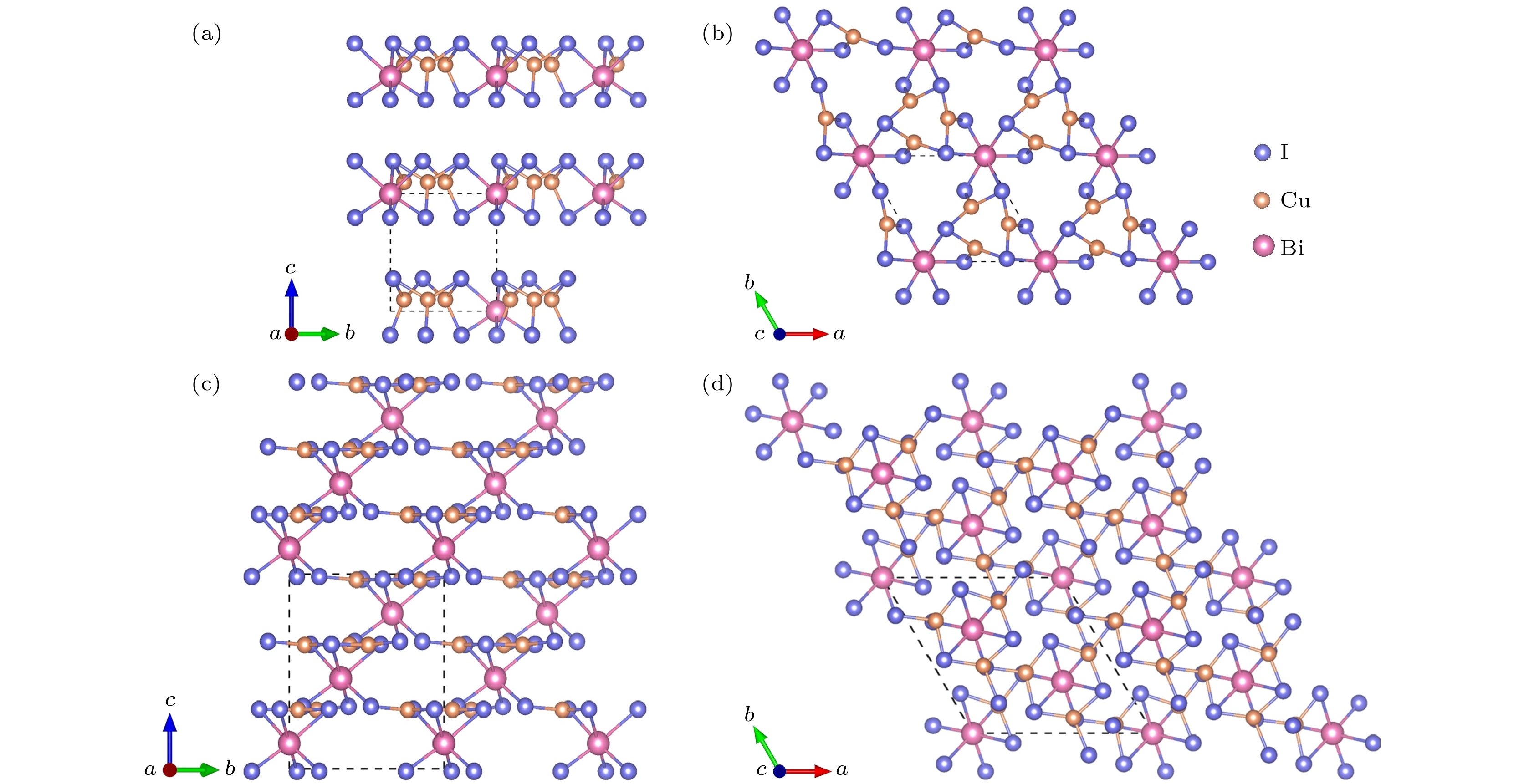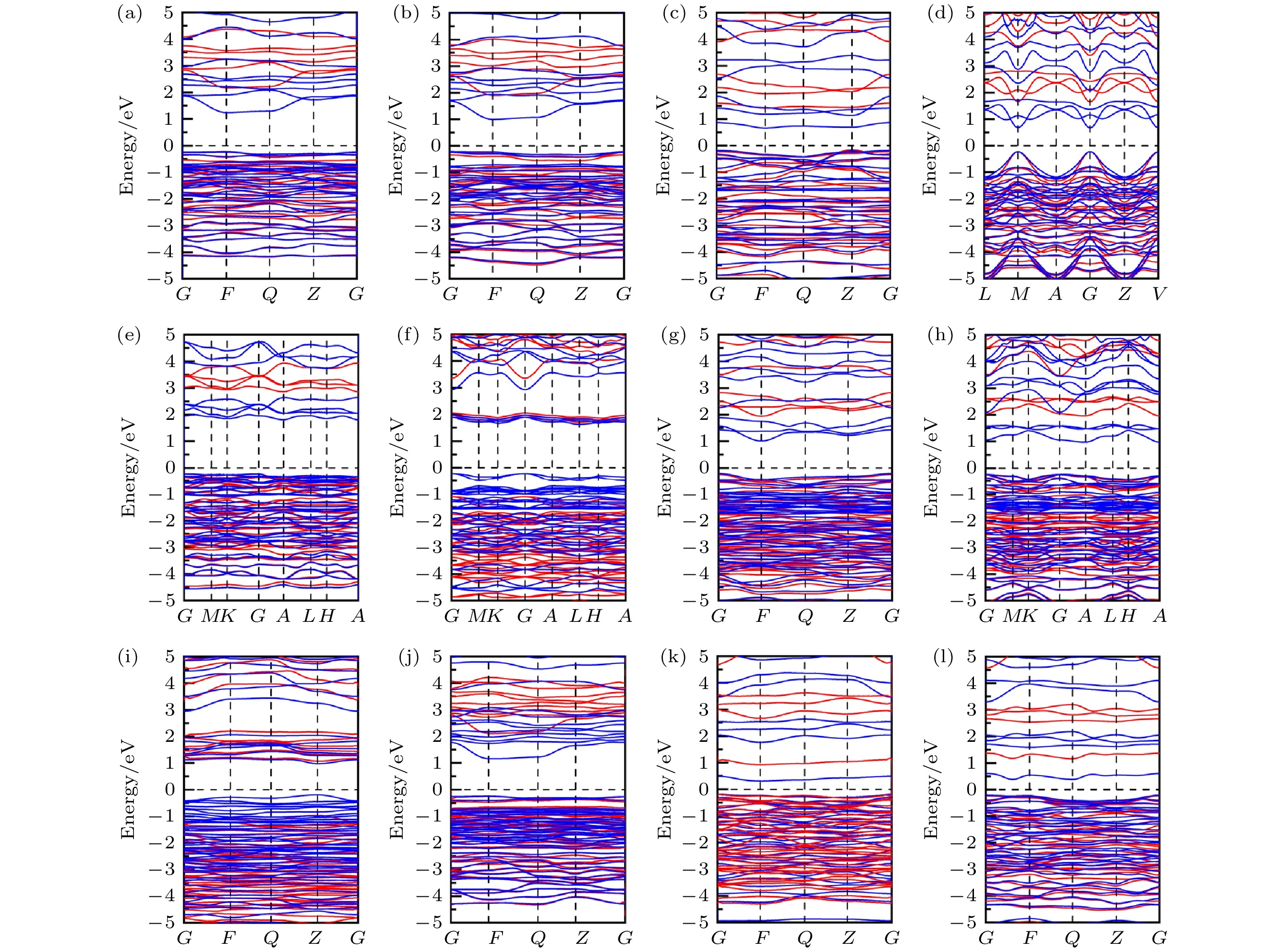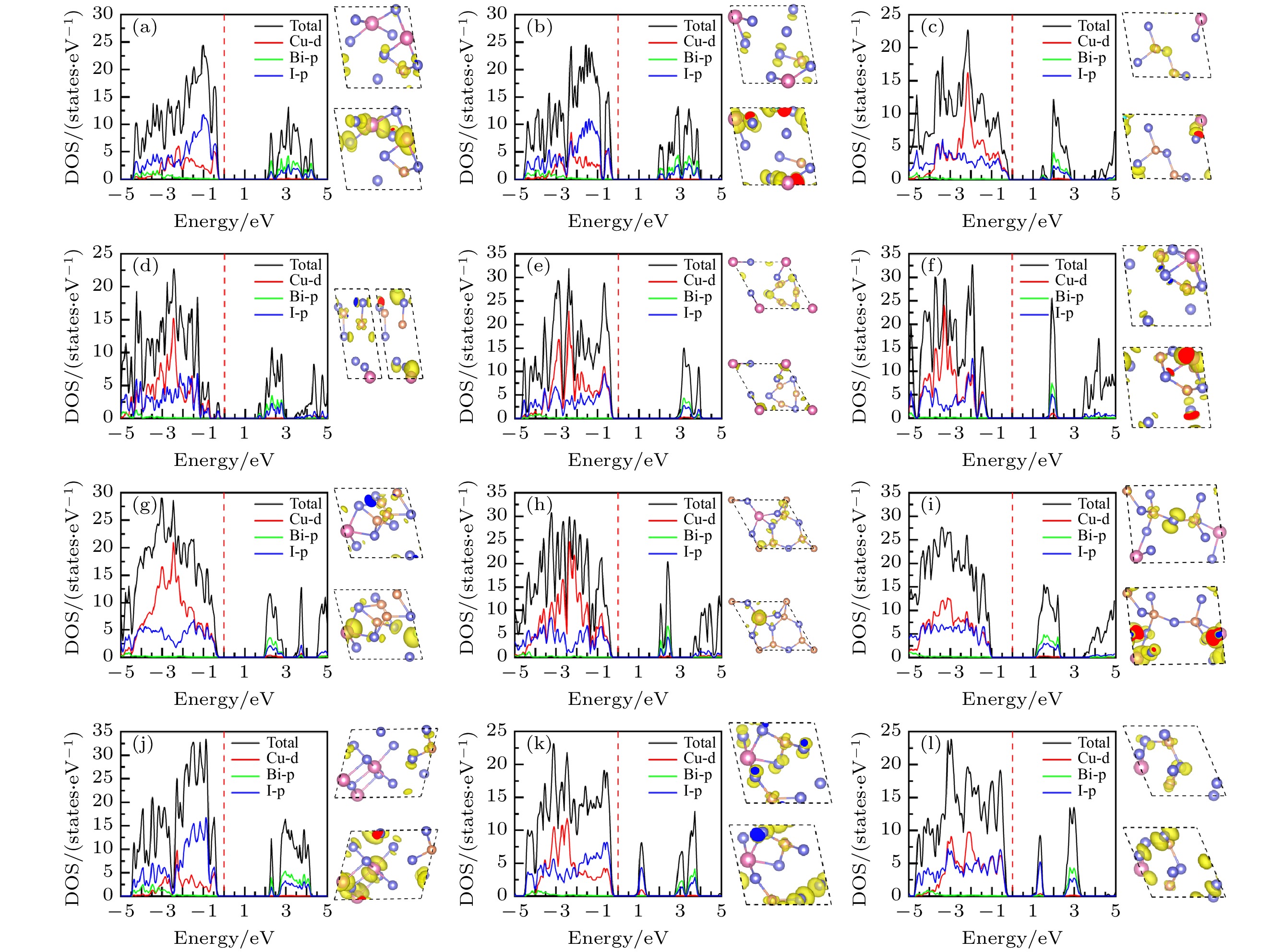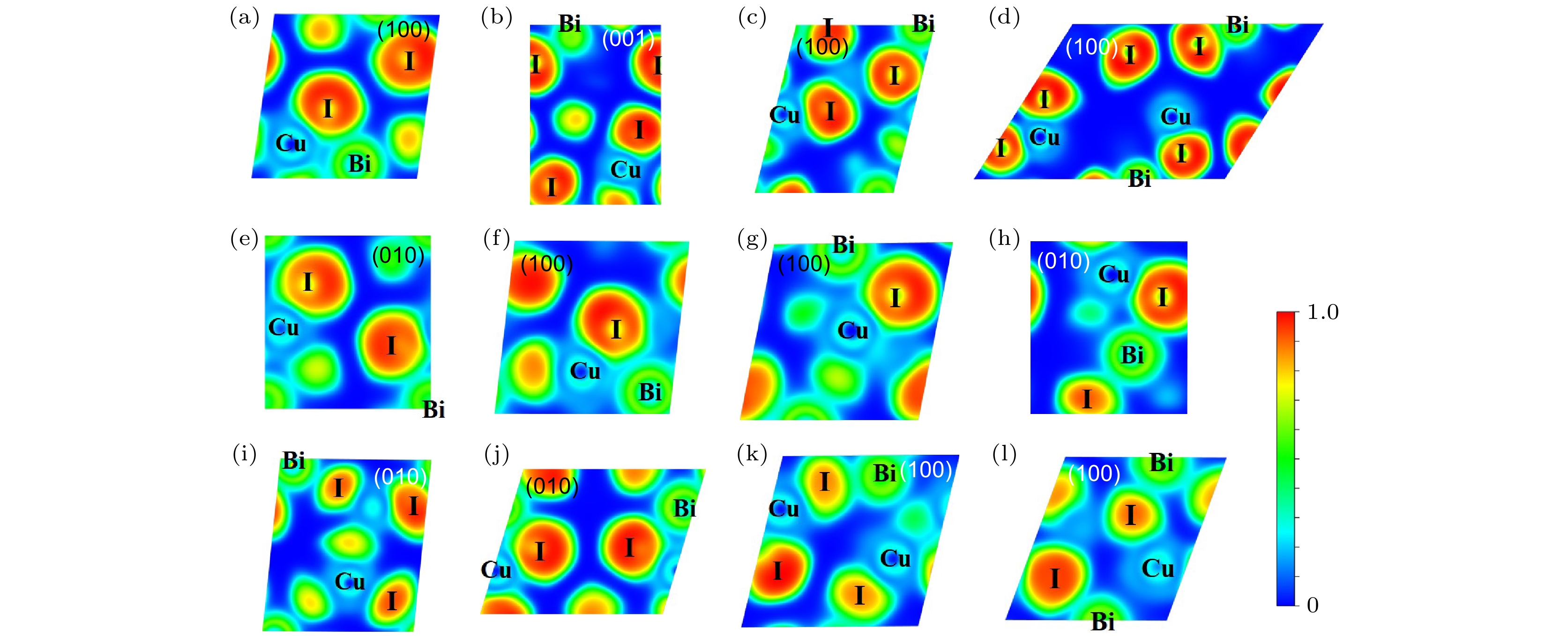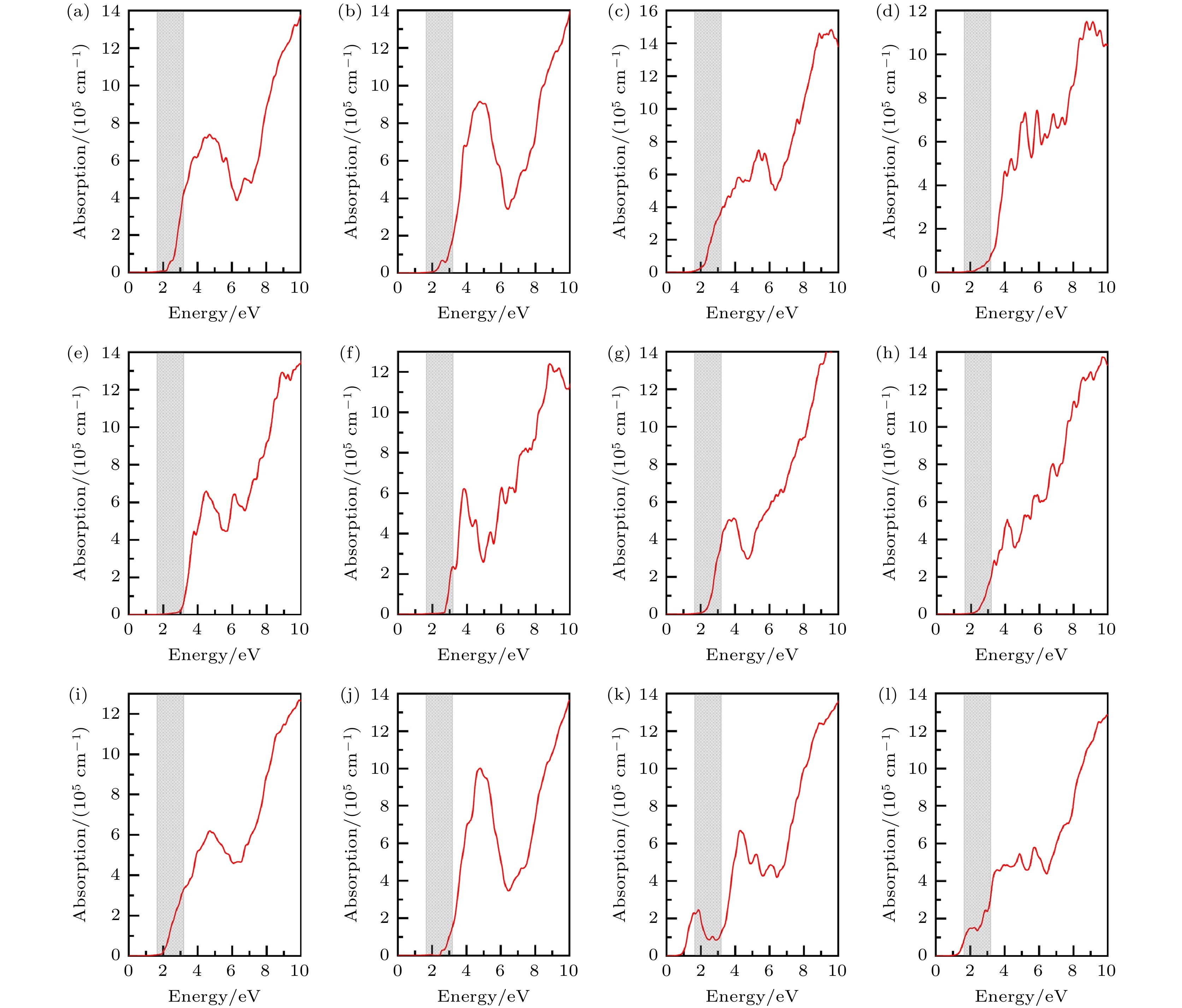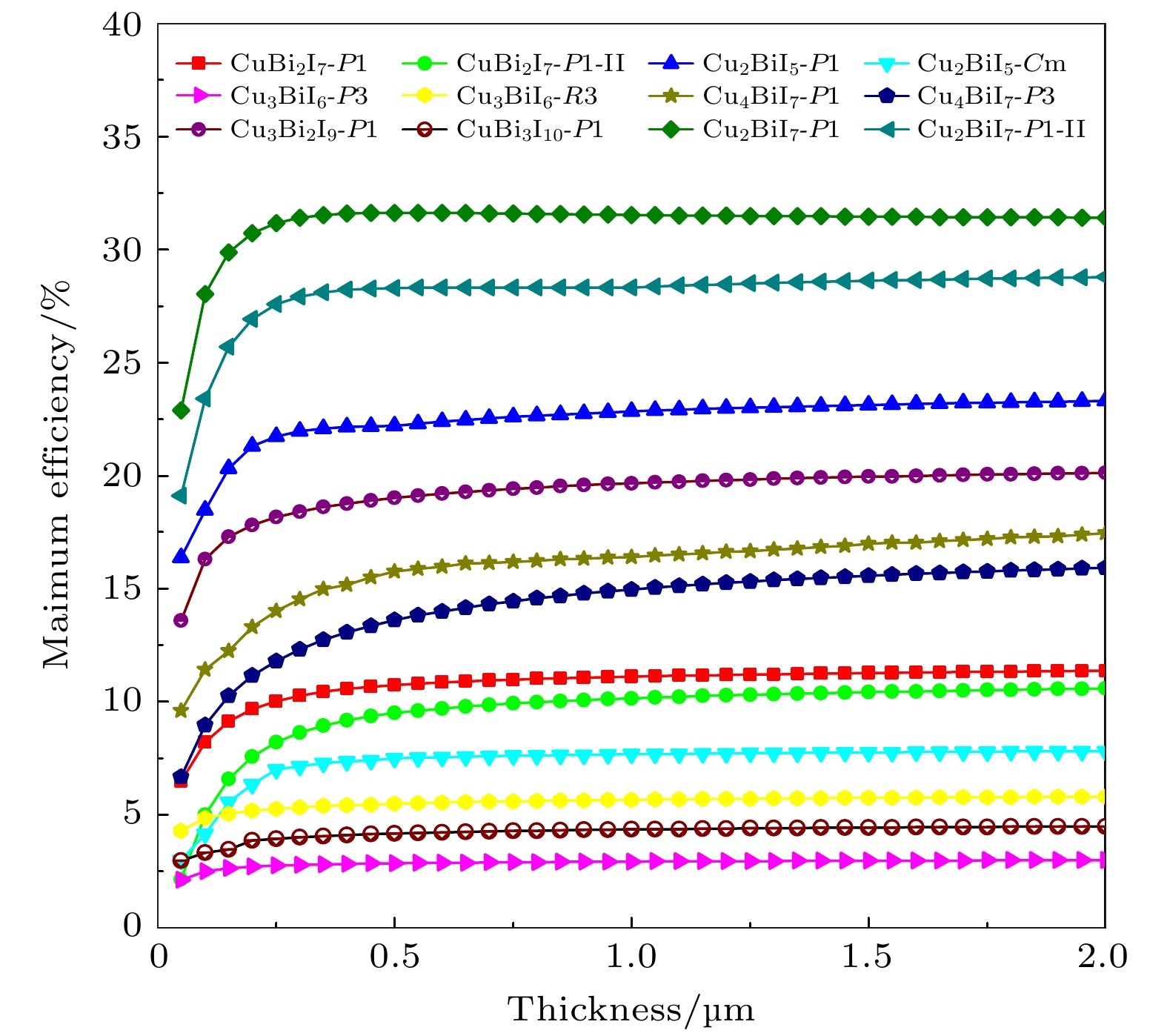-
Ternary metal halides have attracted much attention as a new potential photoelectric material due to their ultra-high photoelectric conversion efficiencies. In this paper, USPEX, a crystal structure prediction software based on genetic algorithm, is used to investigate the potential crystal structures of ternary CuBiI compounds (CuBi 2I 7, Cu 2BiI 5, Cu 2BiI 7,Cu 3BiI 6, Cu 3Bi 2I 9, CuBi 3I 10, and Cu 4BiI 7) at atmospheric pressure and absolute zero temperature. Based on the density functional theory, the formation energies, elastic coefficients, and phonon dispersion curves of the predicted structures are calculated. The twelve stable CuBiI compounds with good thermodynamic, dynamical and mechanical stabilities are identified. The twelve crystal structures of CuBiI compound feature mainly the co-existence of Cu—I and Bi—I bonds and coordination polyhedrons of I atoms. The band gaps of twelve structures, calculated by HSE06 method, are 1.13–3.09 eV, indicating that the stoichiometric ratio affects the band gap obviously. Among them, the band gaps of Cu 2BiI 5- P1, Cu 2BiI 7- P1 and Cu 2BiI 7- P1-II are relatively small, close to the optimal band gap value for light absorption (1.40 eV), demonstrating that these compounds are suitable for serving as light absorbing materials in solar cells. The distribution of density of state (DOS) indicates that the top of the valence band of CuBiI compound is attributed to the hybridized Cu-3d and I-5p orbitals; the bottom of the conduction band of Cu 3BiI 6- R3 comes mainly from the Bi-6p and I-5p orbitals, and Cu-3d contributes little; the conduction band bottom of Cu 2BiI 7is mainly from the I-5p orbital, and the Cu-3d has little contribution. The bottoms of the conduction band of other structures originate mainly from the hybridized Bi-6p and I-5p orbitals. Electronic localization function and Bader charge analysis show that the Cu—I and Bi—I bonds have more ionic features and less covalent natures. The DOS distribution also confirms the covalent interaction of Cu/Bi-I. In addition, the CuBiI ternary compounds have extremely strong light absorption capacities (light absorption coefficient higher than 4 × 10 5cm –1) in the high-energy region of visible light and high power conversion efficiency (31.63%), indicating that the CuBiI ternary compounds have the potential to be an excellent photoelectric absorption material. Our investigation suggests the further study and potential applications of CuBiI ternary compound as absorber materials in solar cell.
-
Keywords:
- ternary metal halides/
- first principles/
- crystal structure prediction/
- photoelectric conversion efficiency
[1] [2] [3] [4] [5] [6] [7] [8] [9] [10] [11] [12] [13] [14] [15] [16] [17] [18] [19] [20] [21] [22] [23] [24] [25] [26] [27] [28] [29] [30] [31] [32] [33] [34] [35] [36] [37] [38] [39] [40] -
Structure
nameSpace
groupNumber of/
(atoms·unit cell–1)Volume/
(Å3·unit cell–1)${{E} }_{\rm{form} }$/
(eV·atoms–1)Structure
nameSpace
groupNumber of/
(atoms·unit cell–1)Volume/
(Å3·unit cell–1)${{E} }_{\rm{form} }$/
(eV·atoms–1)CuBi2I7-P1 P1 10 474.24 –0.362 CuBi2I7-P1-II P1 10 465.35 –0.385 Cu2BiI5-P1 P1 8 295.03 –0.287 Cu2BiI5-Cm Cm 16 742.54 –0.290 Cu3BiI6-P3 P3 10 404.63 –0.265 Cu3BiI6-R3 R3 30 1318.62 –0.244 Cu4BiI7-P1 P1 12 428.29 –0.237 Cu4BiI7-P3 P3 12 451.33 –0.231 Cu3Bi2I9-P1 P1 14 645.41 –0.294 CuBi3I10-P1 P1 14 691.08 –0.402 Cu2BiI7-P1 P1 10 420.79 –0.225 Cu2BiI7-P1-II P1 10 420.68 –0.226 Cij/GPa CuBi2I7-P1 CuBi2I7-P1-II Cu2BiI5-P1 Cu2BiI5-Cm Cu3BiI6-P3 Cu3BiI6-R3 Cu4BiI7-P1 Cu4BiI7-P3 Cu3Bi2I9-P1 CuBi3I10-P1 Cu2BiI7-P1 Cu2BiI7-P1-II C11 8.34 9.03 39.90 4.76 11.99 17.59 23.63 32.25 17.16 2.82 9.71 3.12 C22 12.61 14.16 29.93 35.09 — — 18.34 — 20.42 9.34 14.12 10.34 C33 8.35 9.00 35.71 5.64 5.92 5.05 23.61 8.90 11.86 8.62 14.43 26.51 C44 3.52 3.62 10.18 1.73 1.01 3.53 6.87 1.41 3.91 3.27 6.46 7.16 C55 3.74 2.99 9.96 — — — 7.83 — 3.56 1.91 3.73 4.52 C66 2.41 4.43 6.77 1.24 4.42 6.13 8.72 11.26 6.01 1.93 3.13 3.18 C12 4.73 4.45 9.13 1.63 3.01 5.22 4.56 9.71 6.13 1.96 4.71 3.19 C13 2.61 2.57 14.13 2.77 1.33 2.99 7.76 3.30 3.14 2.11 5.61 6.45 C14 –2.07 –0.04 4.02 — 0.04 1.7 –1.84 0.28 0.51 –0.63 –0.17 –0.32 C15 0.18 0.21 0.18 –0.67 –0.15 –0.38 2.85 0.06 –0.79 –0.21 –2.11 0.54 C16 0.79 2.27 0.12 — — — –0.27 — –0.51 0.86 –1.73 –0.32 C23 2.69 2.76 14.94 2.42 — — 5.49 — 6.79 2.98 7.51 7.18 C24 –2.53 0.12 5.64 — — — –0.99 — 2.280 –0.05 –2.43 2.11 C25 0.28 0.16 0.17 –0.12 — — 2.68 — 0.49 –0.09 –3.12 1.54 C26 0.49 1.72 –0.02 — — — 0.04 — 0.41 1.47 1.35 1.01 C34 –1.69 –0.27 5.74 — — — –0.56 — 2.53 –0.89 –1.51 0.36 C35 –1.76 0.39 0.12 –0.90 — — 3.43 — –0.21 –2.38 –3.43 1.76 C36 1.47 1.17 –0.04 — — — 1.72 — 0.80 0.81 0.13 –0.48 C45 –0.41 0.83 0.13 — — — –0.47 — 0.21 0.85 1.26 0.19 C46 –0.10 0.42 0.01 0.12 — — 1.75 — 0.34 –0.62 –2.13 –0.69 C56 –0.58 –0.29 1.485 — — — –1.07 — 0.94 –0.53 0.82 0.72 Structure name a/Å b/Å c/Å α/(°) β/(°) γ/(°) Cu—I/Å Bi—I/Å CuBi2I7-P1 7.93 7.94 7.92 97.67 82.58 76.98 2.53—2.55 3.02—3.32 CuBi2I7-P1-II 8.05 7.85 7.75 97.64 100.86 100.78 2.54—2.55 3.03—3.22 Cu2BiI5-P1 4.42 7.62 9.57 95.94 103.35 106.82 2.59—2.67 3.09—3.18 Cu2BiI5-Cm 16.64 4.33 12.22 90.00 122.51 90.00 2.57—2.72 2.84—3.50 Cu3BiI6-P3 7.89 7.89 7.54 90.00 90.00 120.00 2.54—2.61 3.02—3.29 Cu3BiI6-R3 11.40 11.40 11.72 90.00 90.00 120.00 2.52—2.56 3.05—3.35 Cu4BiI7-P1 7.61 7.79 7.64 101.68 100.50 98.22 2.56—2.74 3.06—3.22 Cu4BiI7-P3 8.32 8.32 7.52 90.00 90.00 120.00 2.64—2.68 3.09—3.22 Cu3Bi2I9-P1 7.67 8.59 9.85 84.58 88.98 86.74 2.55—2.70 2.99—3.28 CuBi3I10-P1 9.46 10.12 7.85 103.09 106.70 77.25 2.53—2.54 2.99—3.32 Cu2BiI7-P1 7.33 7.90 7.92 104.09 108.49 81.74 2.59—2.64 3.05—3.34 Cu2BiI7-P1-II 9.00 7.78 7.20 109.91 89.24 64.61 2.58—2.70 2.98—3.34 Structure name Eg/eV VBM CBM Bader charge SLME/% HSE06 PBE Cu/(e·atom–1) Bi/(e·atom–1) I/(e·atom–1) CuBi2I7-P1 2.39 1.48 0 0 0 0 0 0 0.33 1.08 –0.36 10.75 CuBi2I7-P1-II 2.13 1.21 0 0 0 0 0.5 0 0.33 1.09 –0.36 9.50 Cu2BiI5-P1 1.56 0.84 0 0 0.5 0 0.5 0 0.34 1.04 –0.34 22.20 Cu2BiI5-Cm 1.87 0.89 0 0 0 0 0 0 0.29 1.07 –0.33 7.50 Cu3BiI6-P3 3.09 1.97 0.05 0 0 0 0 0.5 0.29 1.08 –0.33 2.86 Cu3BiI6-R3 2.81 1.85 0 0 0 0.5 0 0.5 0.31 1.01 –0.32 5.49 Cu4BiI7-P1 2.19 1.22 0 0 0 0 0.5 0 0.30 1.03 –0.32 15.77 Cu4BiI7-P3 2.21 1.21 0 0 0.06 0 0 0.5 0.32 1.06 –0.33 13.61 Cu3Bi2I9-P1 2.03 1.17 0 0 0.5 0 0 0.5 0.34 1.02 –0.34 19.02 CuBi3I10-P1 2.36 1.41 0 0.5 0 0 0.5 0 0.33 1.09 –0.36 4.17 Cu2BiI7-P1 1.13 0.50 0 0 0 0 0.5 0 0.37 1.09 –0.26 31.63 Cu2BiI7-P1-II 1.40 0.60 0 0 0 0 0.5 0.5 0.35 1.06 –0.25 28.30 -
[1] [2] [3] [4] [5] [6] [7] [8] [9] [10] [11] [12] [13] [14] [15] [16] [17] [18] [19] [20] [21] [22] [23] [24] [25] [26] [27] [28] [29] [30] [31] [32] [33] [34] [35] [36] [37] [38] [39] [40]
Catalog
Metrics
- Abstract views:5779
- PDF Downloads:163
- Cited By:0














 DownLoad:
DownLoad:


